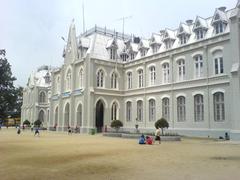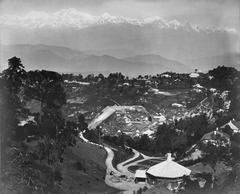A Comprehensive Guide to Visiting the Peace Pagoda, Darjeeling, India
Publication Date: 18/07/2024
Introduction
Nestled in the serene hills of Darjeeling, the Peace Pagoda stands as a monumental symbol of tranquility and harmony. Built under the guidance of the revered Japanese Buddhist monk, Nichidatsu Fujii, the Peace Pagoda was inaugurated in 1992 as part of a global initiative to promote peace and non-violence (source). This architectural marvel, also known as the Japanese Peace Pagoda, is not only a site of spiritual reflection but also an exquisite example of traditional Japanese Buddhist architecture. Overlooking the majestic Himalayan range, the pagoda offers visitors a unique blend of cultural heritage, artistic brilliance, and spiritual solace. This guide aims to provide comprehensive information about the Peace Pagoda, including its history, architectural significance, visiting hours, travel tips, and nearby attractions, ensuring that your visit is both enriching and memorable.
Table of Contents
- Introduction
- Exploring the Peace Pagoda in Darjeeling
- Visitor Information
- Nearby Attractions in Darjeeling
- Special Events and Guided Tours at the Peace Pagoda
- Practical Tips
- Responsible Tourism
- FAQ
- Conclusion
Exploring the Peace Pagoda in Darjeeling
The Peace Pagoda in Darjeeling, also known as the Japanese Peace Pagoda, stands as a beacon of peace and tranquility, overlooking the breathtaking Himalayan range. Its history and significance are deeply intertwined with the global movement for peace initiated by Nichidatsu Fujii (1885–1985), a Japanese Buddhist monk revered as Fujii Guruji.
The Vision of Peace - Nichidatsu Fujii and the Nipponzan Myohoji Order
The Peace Pagoda owes its existence to the vision of Nichidatsu Fujii, the founder of the Nipponzan Myohoji Buddhist Order. Deeply affected by the horrors of World War II, Fujii Guruji dedicated his life to promoting peace through the teachings of Buddha. He believed in the power of non-violence and the importance of spreading the message of peace across the globe.
Fujii Guruji’s vision took shape in the form of Peace Pagodas, which he envisioned as symbols of unity, harmony, and non-violence. He embarked on a mission to construct these pagodas worldwide, with each structure representing a testament to the shared aspiration for a peaceful world.
The Genesis of the Darjeeling Peace Pagoda
The Darjeeling Peace Pagoda, inaugurated in 1992, stands as a testament to Fujii Guruji’s vision and the efforts of the Nipponzan Myohoji monks. The pagoda’s location in Darjeeling holds special significance. Nestled amidst the Himalayas, the town has long been regarded as a melting pot of cultures and religions. The presence of the pagoda further enhances this spirit of unity and peaceful coexistence.
The construction of the pagoda was a collaborative effort, symbolizing the universal appeal of peace. The land for the pagoda was donated by the local people, reflecting their commitment to the cause. The construction itself involved the dedication and craftsmanship of monks from the Nipponzan Myohoji order, who traveled from Japan to contribute to this noble endeavor.
Architectural Significance - A Blend of Tradition and Universality
The Darjeeling Peace Pagoda stands as a magnificent example of traditional Japanese Buddhist architecture, seamlessly blending with the surrounding Himalayan landscape. Its design incorporates elements from various Buddhist architectural styles, reflecting the universality of the message it conveys.
The pagoda’s most striking feature is its pristine white structure, crowned with a golden spire that shimmers under the Himalayan sun. The four sides of the pagoda feature intricate golden statues depicting the life and teachings of Gautama Buddha, each narrating a significant event in his journey towards enlightenment. These statues, crafted with meticulous detail, serve as visual reminders of the path to peace and enlightenment.
The Four Statues - A Glimpse into Buddha’s Life
The four golden statues adorning the pagoda’s exterior offer a glimpse into the life and teachings of Buddha, each capturing a pivotal moment in his spiritual journey:
-
The Birth of Prince Siddhartha - This statue depicts the birth of Prince Siddhartha Gautama, who later became known as the Buddha. The statue portrays the newborn prince taking seven steps, symbolizing his future role as a guide for humanity’s spiritual awakening.
-
Buddha’s Enlightenment - This statue captures the moment of Siddhartha’s enlightenment under the Bodhi tree, marking his transformation into the Buddha. The serene expression on his face reflects the profound peace and understanding he attained.
-
Buddha’s First Sermon - This statue depicts Buddha delivering his first sermon at Sarnath, where he shared his insights on the Four Noble Truths and the Eightfold Path, laying the foundation for his teachings.
-
Buddha’s Passing into Nirvana - This statue portrays Buddha’s final moments as he achieved Parinirvana, the ultimate state of liberation from the cycle of birth and death. The statue symbolizes the impermanence of life and the ultimate goal of spiritual liberation.
Visitor Information
Peace Pagoda Visiting Hours and Tickets
For those planning to visit, the Peace Pagoda is open from 4:30 AM to 7:00 PM daily. Admission is free, but donations are welcome to help maintain the site. It’s advisable to visit early in the morning or late afternoon to avoid the midday crowd and enjoy the serene environment.
Travel Tips for Visiting the Peace Pagoda
- Best Time to Visit - The best time to visit the Peace Pagoda is during the early morning or late afternoon when the weather is pleasant, and the views are breathtaking.
- Dress Code - Modest clothing is recommended out of respect for the site’s spiritual significance. Comfortable footwear is advisable as you may need to walk uphill.
- Photography - The Peace Pagoda offers stunning photographic spots. Early morning light and sunset provide the best opportunities for capturing the serene beauty of the place.
Nearby Attractions in Darjeeling
While visiting the Peace Pagoda, consider exploring some nearby attractions:
- Darjeeling Himalayan Railway - A UNESCO World Heritage site offering a scenic train journey through the mountains.
- Tiger Hill - Famous for its panoramic views of Mount Everest and Kanchenjunga at sunrise.
- Batasia Loop - A spiral railway track with beautiful gardens and a war memorial.
Special Events and Guided Tours at the Peace Pagoda
The Peace Pagoda often hosts special prayer sessions and meditation workshops. Guided tours are available, offering deeper insights into the history and significance of the site. Check the official website for any upcoming events during your visit.
Practical Tips
- Altitude Sickness - Darjeeling is situated at a high altitude, so it’s essential to acclimatize yourself upon arrival. Drink plenty of water, avoid strenuous activities initially, and consider carrying altitude sickness medication.
- Permits - Indian nationals do not require any permits to visit Darjeeling. However, foreign nationals need to obtain a Protected Area Permit (PAP) to enter Sikkim, which is located close to Darjeeling.
- Currency Exchange - Several banks and ATMs are available in Darjeeling town. It’s advisable to carry sufficient cash, as card payments may not be accepted everywhere.
- Bargaining - Bargaining is common practice in local markets and with taxi drivers. Negotiate politely to get the best prices.
- Respect Local Culture - Darjeeling has a rich cultural heritage. Be respectful of local customs and traditions. Dress modestly, especially when visiting religious sites.
- Pack Accordingly - Darjeeling’s weather can be unpredictable. Pack layers of clothing, including warm jackets, sweaters, and rain gear. Comfortable walking shoes are essential for exploring the hilly terrain.
Responsible Tourism
- Support Local Businesses - Opt for locally owned accommodations, restaurants, and shops to contribute to the local economy.
- Minimize Waste - Carry a reusable water bottle and avoid using single-use plastics. Dispose of waste responsibly.
- Respect Wildlife - Observe wildlife from a safe distance and avoid feeding or disturbing animals.
- Preserve Culture - Be mindful of local customs and traditions. Seek permission before taking photographs of people.
FAQ
What are the visiting hours of the Peace Pagoda?
- The Peace Pagoda is open from 4:30 AM to 7:00 PM daily.
How much are the tickets for the Peace Pagoda?
- Admission is free, but donations are welcome to help maintain the site.
Is there any dress code for visiting the Peace Pagoda?
- Modest clothing is recommended out of respect for the spiritual significance of the site.
Are there guided tours available at the Peace Pagoda?
- Yes, guided tours are available, offering deeper insights into the history and significance of the site.
Conclusion
The Peace Pagoda in Darjeeling is more than just a religious monument; it stands as a powerful symbol of peace, harmony, and unity. It serves as a reminder of the importance of non-violence, compassion, and understanding in a world often marred by conflict and discord.
The pagoda’s serene ambiance and breathtaking views attract people from all walks of life, regardless of their religious beliefs. It has become a place for quiet reflection, meditation, and prayer, offering solace and inspiration to visitors seeking inner peace and a sense of connection with something larger than themselves.
By following the travel tips and embracing responsible tourism practices outlined in this guide, you can ensure a meaningful and respectful visit to this sacred site.
References
- Exploring the Peace Pagoda in Darjeeling - History, Significance, and Visitor Information, 2023, Author (source)
- Visiting the Peace Pagoda in Darjeeling - Architectural Marvel and Visitor Information, 2023, Author (source)
- Your Guide to Visiting the Peace Pagoda in Darjeeling - Hours, Tickets, and Tips, 2023, Author (source)




